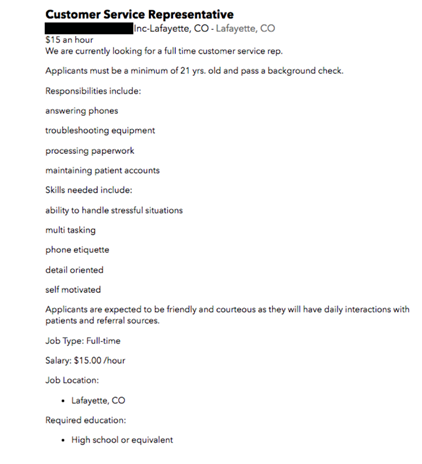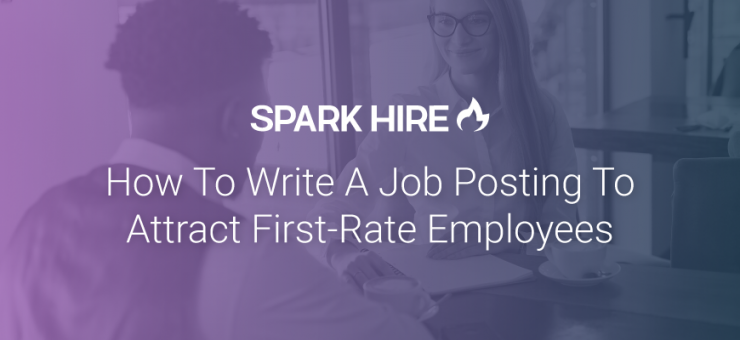A fine dress helps to impress. This proverb perfectly relates to job postings. They obviously help you attract the right candidates but if you don’t fulfill your promises, you might get candidate backlash.
So, how do you write a job posting that helps you lure top-notch candidates and sift through candidates that don’t fit into your corporate culture? With a concise vacancy description, and a quick study of good and bad job postings, you will convert job seekers into candidates, and do so efficiently with the use of job posting sites.
Job posting 101: definition and structure
Before we delve into the subject, let’s find out the difference between a job posting and job description since even savvy HR and recruiting managers confuse these two.
While the job description focuses on a detailed description of candidates’ competencies, soft and hard skills, and responsibilities, a job posting aims at “selling” the company and vacancy to a candidate. Basically, it’s like marketing for HR.
Marketers devise value propositions for their target audience to tap into the audience’s fears and desires while HR managers create appealing job postings. The goal is to highlight employee value propositions (EVPs) and tell about the company and team in a way that makes candidates want to work for you.
A typical structure of a job posting includes:
-
- A job title with a name of an actual position. For example, if your position mainly includes communication with internal staff, it’s better to come up with a name like “Internal Communications Manager” rather than “Community Manager” since the latter has a broader range of responsibilities.
- A lead specifying the most luring details of a vacancy like perks and bonuses on the position or a team.
- The information about the company or the project to build empathy between you and a candidate.
- Employee value propositions answer the question “what’s in it for me?” Include information about your employee benefits, location, opportunities for professional growth, and anything would appeal to your perfect candidate.
- Responsibilities to weed out candidates that don’t fit into the position with their skill sets. However, don’t be too harsh when talking about responsibilities. Ideally, your description must encourage candidates to apply, not scare them off with unachievable tasks.
- An application process that sets candidates’ expectations and caters to overall candidate experience.
Consider this job posting template as a starting point you can modify and extend.
Best practices of a well-written job posting
#1. Write for your target audience
Marketers use the definition of a target audience to specify the group of people that may be potentially interested in their goods of services.
HR Managers and recruiters should treat their candidates as a target audience, too. You need to elicit key information about your target audience like:
- Demographics: their age, location, marital status, children, income, etc
- Pain points: specific issues they experience and need to solve. For example, junior level specialists are looking for actualization and mentoring opportunities while senior specialists might need recognition of their professional achievements.
- Objections: reasons why a candidate rejects your job offer. For instance, your position offers little or no career growth opportunities or involves hazardous jobs.
Information about your target audience of candidates allows you to craft specific, to-the-point messages in job postings that deliver a desired message and appeal to them.
Think about it: informal language with youth slang isn’t appropriate for job postings with senior level vacancies. However, they can be efficient when you’re targeting millennials or Generation Z that appreciate a relaxed and casual tone.
#2. Share your corporate culture with candidates
Cultural fit is as important as skills, competencies, and experience for your future candidate. To help candidates figure out if they fit in, include the following information in your job posting:
- Your mission and vision. Describe your company’s mission and vision so candidates know what you’re striving for and what goals you pursue. For example, Microsoft’s mission is: “Our mission is to empower every person and every organization on the planet to achieve more”.
- Your values. Values are guidelines that maintain your organizational identity and differentiate yourself from others. To stand out from the competition, Adidas states that performance, passion, integrity, and diversity are their values.
- Essential attributes of your company culture. To give your candidates a broader perspective, talk about your workplace and team. Are you a bunch of workaholics or you believe in a 9 to 5 schedule to keep a healthy work life balance? Don’t be afraid to reveal your inner self to attract people that share the same values and approach to work.
#3. Promote vacancies in places where your target audience live
Writing an efficient job posting template isn’t everything. The next step is to reach out to the right candidates in the right place.
Social media websites like LinkedIn and Facebook are popular among HR because they offer a wide reach to target candidates and comprehensive communication opportunities, including paid advertising and precise targeting.
Traditional job posting sites like Indeed, Glassdoor, Monster remain in favour of recruiters because they offer a wide talent pool and advanced search options. With job posting sites, you can reach out to a broad audience with versatile demographics.
Company newsletters can also be a great source of referral candidates that come from recommendations of your employees.
Job posting examples you can learn from
Now let’s solidify our knowledge and compare some of the postings.
- Here’s a job posting for a Customer Service Representative that at first glance doesn’t seem so bad.

But, when looking closely, we can find several gaps that need to be filled.
- First, the job posting has no attractive lead or a summary that would make applicants read it
- Second, the text is flooded with bullet points that make a job posting dull.
- Finally, the text is focused on employers, not to-be employees. It contains a list of responsibilities and requirements for a candidate, but doesn’t provide much information about the actual job a candidate must do. Also, the section with perks and bonuses should specify more benefits and EVPs to make a candidate want to work for the organization.
2) The next job posting example is for a nurse vacancy. As you can see, it covers all essential blocks: from a compelling and attractive lead to a company description, and compensation. This job posting focuses on working conditions like a well-staffed hospital and a location. These factors are essential to nurses that get tired of overtimes and patient loads. Thus, this job posting has all chances to generate valid candidates.

Wrapping up
An efficient job posting should not just include essential blocks like a company’s description and candidate’s responsibilities, but also talk about corporate mission and identity. Perfect candidates should fit in from the start, so make sure you pick the right words and form to convey your message.
About the Author
 David Roberts is skilled at executing revenue-generating strategies for clients, breaking into saturated markets and identifying growth opportunities. He is proficient in media production, social media marketing, graphic design and advertisement development.
David Roberts is skilled at executing revenue-generating strategies for clients, breaking into saturated markets and identifying growth opportunities. He is proficient in media production, social media marketing, graphic design and advertisement development.











